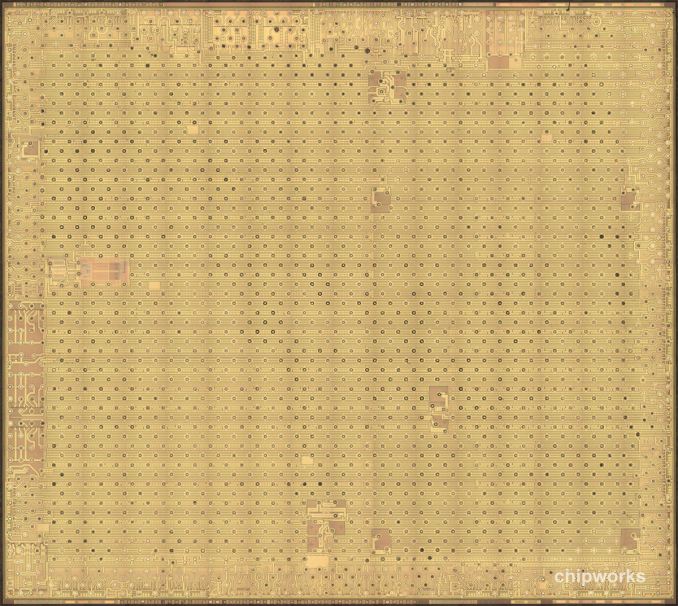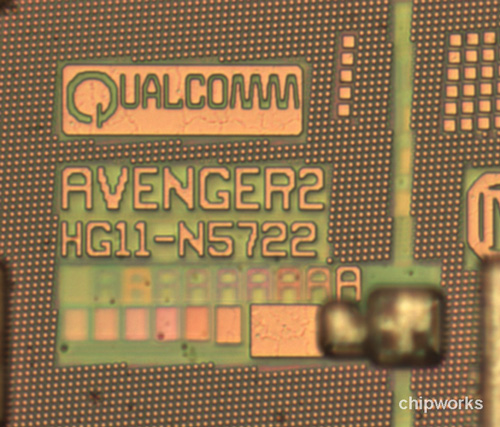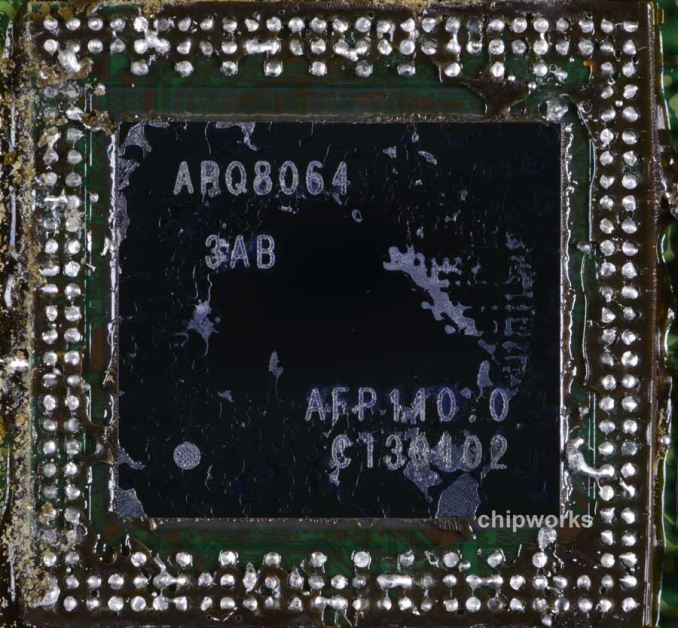Samsung Galaxy S 4 Review - Part 1
by Brian Klug on April 24, 2013 12:01 AM ESTGalaxy S 4 - Powered by a Better Snapdragon 600 (APQ8064AB)?
At a high level, Samsung's Galaxy S 4 integrates Qualcomm's Snapdragon 600 SoC. From what Qualcomm told us about Snapdragon 600, we're dealing with four Krait 300 cores and an Adreno 320 GPU. The Krait 300 cores themselves are supposed to improve performance per clock over the original Krait CPU (Krait 200) through a handful of low level microarchitectural tweaks that we've gone through here. The Krait 300 design also allegedly improves the ability to run at higher frequencies without resorting to higher voltages. This isn't the first time we've talked about Snapdragon 600, but since then a few things have come to light.

Snapdragon 600 from HTC One - Chipworks
For starters, Chipworks got their hands on a Snapdragon 600 SoC (from an HTC One) and delayered the SoC. In its investigation, Chipworks discovered that Snapdragon 600 had the exact same die area as the previous generation Snapdragon S4 Pro (APQ8064). Also, although you'd expect APQ8064T markings on the chip itself, the part carried the same APQ8064 label as previous S4 Pro designs.

Avenger 2 Markings on Snapdragon 600 die from HTC One - Chipworks
Chipworks did note however that there were some subtle differences between a standard APQ8064 and the Snapdragon 600 SoC from the HTC One. The Snapdragon 600 from the One is labeled with an Avenger2 codename rather than Avenger, the latter was apparently present on prior APQ8064 designs. Chipworks also noticed differences in the topmost metal layer, although it's not clear whether or not they stopped there or found no differences in lower layers.
All of this points to a much more subtle set of physical differences between APQ8064 and the earliest Snapdragon 600s. Metal layer changes are often used to fix bugs in silicon without requiring a complete respin which can be costly and create additional delays. It's entirely possible that Krait 300 was actually just a bug fixed Krait 200, which would explain the identical die size and slight differences elsewhere.
That brings us to the Galaxy S 4. It's immediately apparent that something is different here because Samsung is shipping the Snapdragon 600 at a higher frequency than any other OEM. The Krait 300 cores in SGS4 can run at up to 1.9GHz vs. 1.7GHz for everyone else. Curiously enough, 1.9GHz is the max frequency that Qualcomm mentioned when it first announced Snapdragon 600.
Samsung is obviously a very large customer, so at first glance we assumed it could simply demand a better bin of Snapdragon 600 than its lower volume competitors. Looking a bit deeper however, we see that the Galaxy S 4 uses something different entirely.
APQ8064 from a Snapdragon 600 based HTC One - Chipworks
Digging through the Galaxy S 4 kernel source we see references to an APQ8064AB part. As a recap, APQ8064 was the first quad-core Krait 200 SoC with no integrated modem, more commonly referred to as Snapdragon S4 Pro. APQ8064T was supposed to be its higher clocked/Krait 300 based successor that ended up with the marketing name Snapdragon 600. APQ8064AB however is, at this point, unique to the Galaxy S 4 but still carries the Snapdragon 600 marketing name.
If we had to guess, we might be looking at an actual respin of the APQ8064 silicon in APQ8064AB. Assuming Qualcomm isn't playing any funny games here, APQ8064AB may simply be a respin capable of hitting higher frequencies. We'll have to keep a close eye on this going forward, but it's clear to me that the Galaxy S 4 is shipping with something different than everyone else who has a Snapdragon 600 at this point.











335 Comments
View All Comments
darwinosx - Wednesday, April 24, 2013 - link
Anyone who complains the iPhone is too light need to reevaluate their priorities.medi02 - Monday, April 29, 2013 - link
Plastic does NOT get either dirty or scratched easier than metal, this is from an owner of 2+ year old galaxy S+, who never used any sorts of protective cover. The only marks on it are from dropping it on concrete from about 1.6 meters.This "it must be metal" madness should stop. Go apply that to other gadgets.
hyperdoggy - Wednesday, April 24, 2013 - link
If it doesn't come off looking like a 5 dollar chinatown toy, then yes. Don't get me wrong, there's nothing wrong with plastic, HTC and Nokia does it well, but the fisher price mode that samsung is in, i can't help but to feel Samsung could of done it a lot better.emkei - Tuesday, April 30, 2013 - link
Do you seriously think galaxy look like 5 dollor toy? lol.....n3xas - Wednesday, April 24, 2013 - link
Your argument is invalid. Smaller display is not a con for many people. You can't judge battery life by the capacity alone. Larger because of the speakers, I prefer larger any day to cuping the phone with my hands like an idiot and trying to hear something. Resistance to breaking or scratching still unknown. Heavier? yes, aluminum is heavier than plastic.danbob999 - Wednesday, April 24, 2013 - link
Smaller display IS a con. It's just that it often comes with a benefit: smaller overall phone.Samsung did the impossible and made a phone which is both smaller and has a larger display than the competition.
If the Galaxy S4 was of the same size but with a 4" display it would suck.
Resistance to breaking might be unkown, but it is known that light plastic devices survive better to drops than heavy alluminium ones. Plastic is light, absorbs shock and let waves pass through. Perfect material for a phone. If you want an heavier phone noone stops you from attaching a lead plate to its back.
Thud2 - Thursday, April 25, 2013 - link
"but it is known that light plastic devices survive better to drops than heavy aluminium ones"Oh, "it is known"?
That kind of attribution is not acceptable.
danbob999 - Thursday, April 25, 2013 - link
Are you really denying that plastic is more shock-absorbant than metal?Krolkrowa - Thursday, May 9, 2013 - link
Smaller display in not a con in this situation. The HTC has a better ppi and it has a LCD3 display which is actually better than the AMOLED screen on the Galaxy S4. The colours on it are just better and the blacks are not that bad. 0.3" is not much difference, if you want 25 reasons why HTC One is better check this video out from PhoneBuff on YouTube: http://www.youtube.com/watch?v=RHIXtw34wK4darwinosx - Wednesday, April 24, 2013 - link
From the review;"If you compare the all-plastic Galaxy S 4 to the all-metal HTC One, there's a difference of 13 grams."
I've seen several articles saying that Samsung is going to be upping their build quality because of the HTC One and iPhone and the constant perception by so many people that Samsung phones and tablets feel and look cheap.